A technology’s got to know its limitations

Informed Sources
Be gone dull care! What if the timetable is in chaos, franchises are losing money and infrastructure renewal is unaffordable, I’m going to do what I enjoy most and write about technology. And the technology du jour is the replacement of the diesel engine in rail traction.
On 12 February, recently appointed Transport Minister Jo Johnson announced his ambition to ‘take all diesel-only trains off the track by 2040’. He made no apology for that ‘ambitious goal’, since the Government was already committed to ending sales of petrol and diesel cars by the same date. ‘If we can achieve that, then why can’t the railway aspire to a similar objective?’ he asked.
While conceding that rail is already less carbon-intensive than road, Mr Johnson argued that this ‘does not absolve the rail industry from cleaning up its own act’. In support of this statement he quoted the unsupported factoid that ‘in absolute terms’, rail emissions have increased by a third since 1990, a situation that ‘cannot go on’.
FACTOID
At this point it is time to introduce a phrase used by the students against defenders of gun control after the Florida shootings: ‘I call BS’. What does the minister mean by ‘absolute terms’? Which particular emissions is he talking about?
Presumably he means the units of whatever emissions he has in mind, as opposed to some relative metric such as volume of carbon dioxide or Nitrous Oxide (NOx) per passenger kilometre. Data is available on the average carbon footprint of electricity from the national grid. And you can use this to work out the CO2 generated by an IC225, say, on an average journey.
Or you can take Network Rail’s traction electricity consumption, divide by passenger mileage on the electrified network, to get CO2 per passenger kilometre. With ridership rising on much the same size of railway over the last two decades, this should make the railway look good, environmentally.
But ’tis all sophistry. Let’s take it that Mr Johnson is focused on diesel emissions (NOx and particulates), which have replaced global warming (CO2) in the political consciousness. This is confirmed by his reference to the ‘real prize’, which is the ‘introduction of zero-carbon alternative-fuel trains to the network’. He looks forward to a hydrogen train trial ‘in the next Control Period (2019-24)’.
Pedants will point out that hydrogen is carbon-free only if produced by electrolysis using nuclear, hydro-electric or solar power. But we’re dealing with a politician here, so let’s not break a butterfly on a wheel.
IMPROVEMENT
Anyway, 1990 is an interesting year to choose as the baseline for railway diesel emissions. These would have been falling up to then with the commissioning of nearly a thousand route miles of electrification in the previous decade. Then, of course, investment in electrification stopped for two decades.
But during this interregnum diesel traction emissions should have continued to improve thanks to the post-privatisation orders for new trains powered by increasingly ‘clean’ diesel engines. The final Turbostars, for example, incorporated second-generation power units with even lower emissions.
Similarly, the replacement of all the late-1960s Paxman Valenta engines in the Class 43 stud with modern MTU 4000 Series or MAN VP185s will have done wonders for the station environment. Compare the clouds of clag from a Valenta starting up with the almost imperceptible brownish haze over the power cars today.
Mr Johnson mentioned ‘old diesels’ going, instancing the InterCity 125, and being replaced by ‘much cleaner trains featuring low carbon and NOx technology’. This must refer to the Euro IIIb MTU engines in the Class 800 bi-modes that include exhaust after-treatment and are significantly cleaner in terms of NOx and particulates than the older MTU power units in the Class 43 power cars.
POWER
When Boswell visited the Boulton & Watt manufactory in 1767, Mathew Boulton told him ‘I sell here, Sir, what all the world desires to have – power’. And in rail traction power is as desirable as ever.
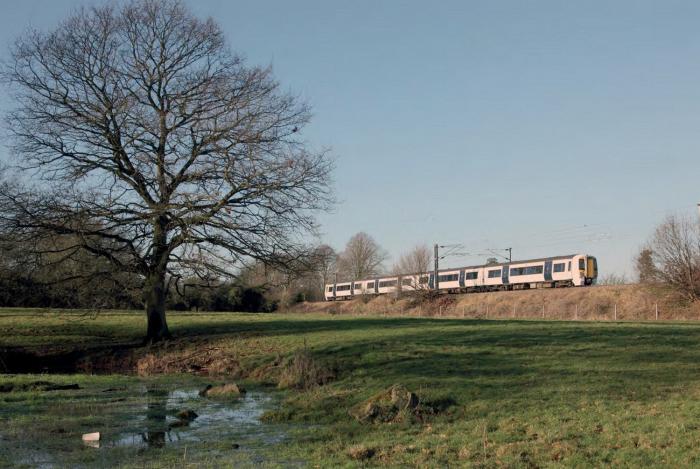
Before investigating alternatives, we need to understand the power demands of duties currently carried out by diesel traction. Remember that the basic Diesel cycle, with a capital ‘D’, is the most thermally efficient of the various internal combustion cycles.
Professor Roger Kemp’s 2007 paper on ‘Traction energy metrics’ for the Rail Safety & Standards Board (RSSB) provides the necessary data. In the case of IC125 the fuel consumption of the Midland main line fleet was measured over a collective mileage of 300,000km. The average fuel consumption was 4.2 litre/km.
Diesel fuel has an energy density of 9,700 Watt hours/litre, giving an average energy consumption for the MML IC125 fleet of 40,600Wh/km, or 40.6kWh/km.
This sets the baseline against which the potential for batteries in similar applications can be assessed. But remember that both batteries and hydrogen fuel cells store electrical energy produced elsewhere while IC125 generates its own power.
Table 1 is derived from data in Prof Kemp’s paper, which included both simulations and measured consumption. His chosen metric, in comparing the efficiency of a range of diesel and electric trains, was energy consumption per 100 seat/km.
When comparing existing traction with alternative power sources, the key issue is how much energy is needed for a journey, so for the table I have used Roger Kemp’s data to calculate kWh per kilometre.
At first sight it appears an IC125 is very inefficient compared with, say, the IC225. But the IC125 generates its electricity on board, incurring the thermal losses in the diesel engine. With electric traction the equivalent losses have been incurred at the generating plant
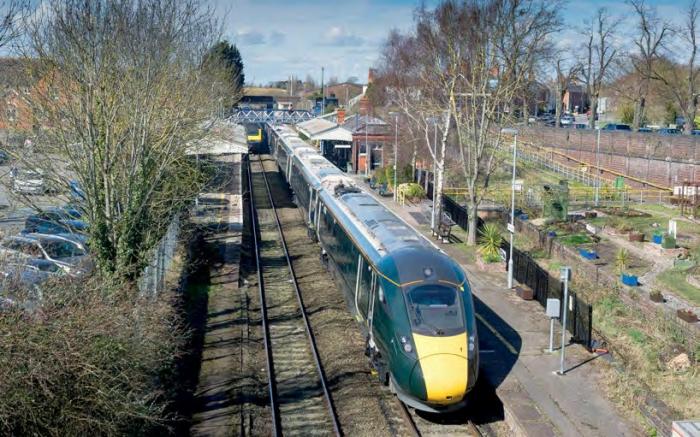
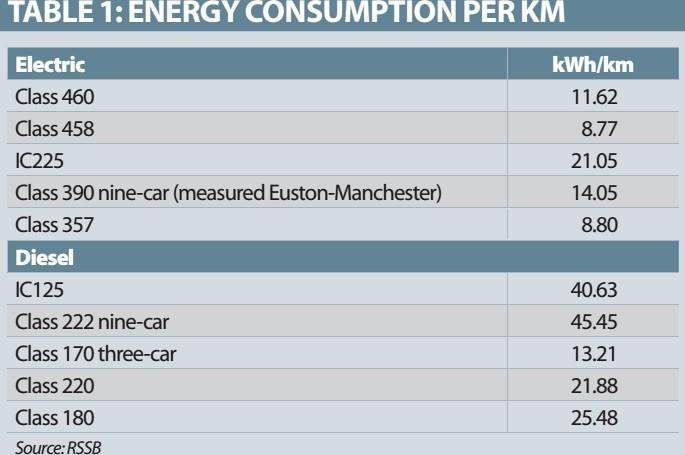
PRACTICALITY
Back to Mr Johnson’s speech where he said, ‘in time, as battery technologies improve we expect to see the diesel engines in bi-modes replaced altogether’. Of course, he didn’t make that up himself, it was written by a DfT civil servant and I expect you know my views on DfT’s technical expertise by now.
A five-car Class 800 bi-mode with its three engines running derated for reliability has the same power as a Class 43 power car and a balancing speed of 190km/h. Its three MTU 1600 Series engines each sip 197 grams of diesel for each kWh. Some simple maths gives the energy consumption at full chat of 19.6kWh/km. This provides a useful sense check as it is roughly half that of the IC125, which is (roughly) twice as long and runs faster but is only 60% heavier. Each diesel power pack, which weighs about six tonnes, will go on belting out around 6.5kWh per kilometre until the 1,290kg of diesel in the fuel tank runs out.
I mentioned the weight of the fuel because the Class 800 is a modular design and could be modified to accommodate the needs of operators or to include new technology. So each powered vehicle has 7.4 tonnes of available mass if the power module and fuel tank are swapped out and replaced by battery packs.
CAPACITY
Well, you might think that 7.4 tonnes is quite a lot, given that the current rule of thumb for lithium ion (Li-Ion) battery energy density is around 250Wh/kg. But that excludes all the associated equipment needed to transform the energy into power, possibly a cooling system and so on.
There is an analogy with the Class 800 diesel power pack. A full tank holds 15MW hours of energy but needs six tonnes of engine to turn it into useful work.
Table 2 (overleaf) compares the ratings of battery packs for three real life traction applications – the Brush-Hitachi Hayabusa IC125 bi-mode, the Bombardier Class 379 experimental Independently Powered EMU (IPEMU) and the CAF Birmingham tram described in last month’s magazine. The practical energy density comes out at around 50Wh/kg.
BI-MODE CONVERSION
So what does this mean for Mr Johnson’s aspiration to have the diesel engines in bi-modes ‘replaced altogether’ by batteries? Well, the first question is whether you would replace all the engines. Remember that even all-electric Class 801s will still have a bi-mode power pack. This is intended to move the train slowly if the traction power is off and supply hotel power for longer than batteries.
But let’s assume that we have the weight of three power packs and fuel tanks to play with in our theoretical Class 800-e. We can’t use the energy per kilometre under diesel power because that includes the 40% energy efficiency of the diesel engine.
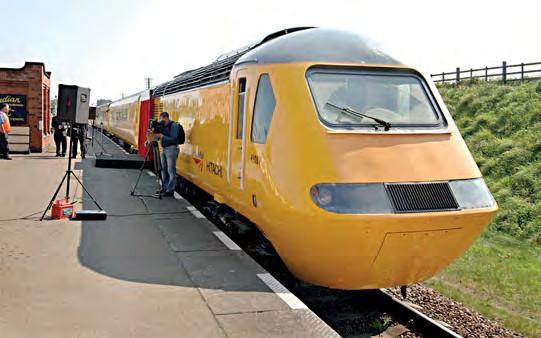
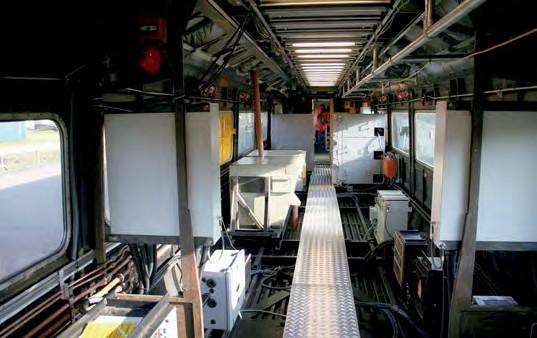
To provide an electric surrogate for a five-car Class 800, the nearest match in Table 1 is the eight-car Class 460 Gatwick Express. With three battery packs with an energy density, as installed, of 50Wh/ kg, I make the range of the Class 800-e around 60 miles at 125mph timings.
Of course this is based on a rough and ready calculation. On potential routes speeds might be lower and regenerative braking would extend the range. On the other hand the heating/air conditioning and other ‘hotel services’, say 300kW, would also have to come from the battery. So my notional Class 800-e could handle Didcot-Oxford or Wootton Bassett-Bristol Temple Meads, via Bath. But Penzance or Inverness are off the agenda.
Apart from exposing the unreality of Mr Johnson’s aspirations, these calculations also explain why the Rail Freight Group was so concerned by the implications of no diesel traction after 2040. More on that in another column.
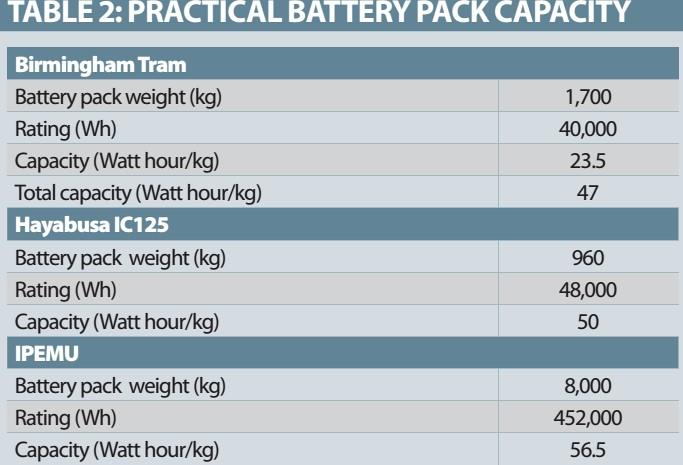
D-TRAIN
So much for inter-city. Meanwhile, Vivarail is working on its first production battery-powered two-car unit. The D-train is nothing if not modular and conversion to battery power involves taking out the two engine modules under each vehicle and replacing them with lithium-ion battery packs.
These give a total capacity of 106kWhr and a range of 40 miles.
An eight-minute charge at each end of the journey is claimed to be sufficient to top up the battery for the return trip. With a 10-minute charge the range is extended to 50 miles.
Range is expected to increase as battery technology develops, but then then everyone says that. Moore’s Law, that the number of transistors in an integrated circuit doubles approximately every two years, is often quoted in aid. Sadly, the laws of chemistry are less accommodating than advances in silicon chip manufacturing.
You can see practical roles for Vivarail’s lightweight battery train on captive services like the Watford-St Albans Abbey shuttle.
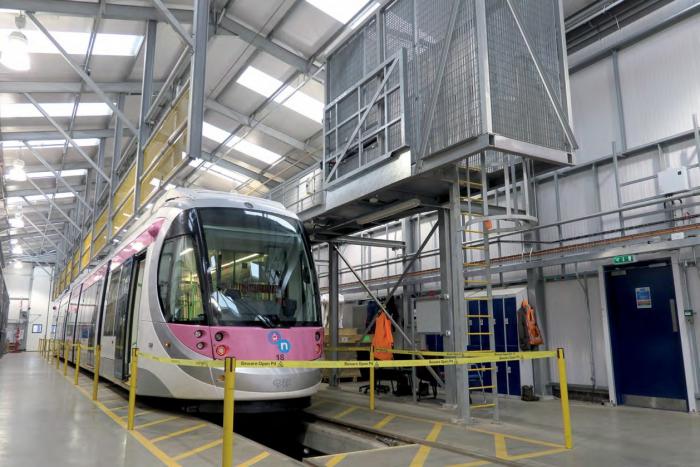


But this highlights another problem with applications for the Class 379 IPEMU concept. If you are running through services beyond the wires, every EMU in the fleet has to slug around batteries all day, every day on the off-chance it might be diagrammed onto the branch.
CHOCKS AWAY
Meanwhile, as a footnote, battery-powered aircraft are receiving massive funding in the United States and Europe. Über, for example, is working on urban air transport using electric Vertical Take Off and Landing (eVTOL) air taxis. For the technically minded, Über’s goals require a power output of 300kW from a 140kWh battery pack and a battery energy density of 400Wh/kg.
A NASA study of eVTOL makes a point relevant to rail battery application. Doubling the range of a notional eVTOL aircraft from 50 to 100 miles increases the gross weight of the aircraft by 50%. With diesel power the increase would be only 2%.
Perhaps the most ambitious development comes from Israeli company Eviation Aircraft. With a 900kWh battery system using 260Wh/kg cells, its Alice nine-seat passenger aircraft is projected to have a range of up to 650 miles: the prototype is scheduled to fly by early 2019. More interesting numbers quoted for this project include a battery life of 1,000 cycles, equivalent to 3,000 flying hours. Battery replacement cost is given as £175,000.
HYDROGEN POTENTIAL?
If batteries are niche in rail traction, what has the other alternative energy source – hydrogen – got to offer?
Hydrogen fuel cells generate electricity by stripping the electrons from the hydrogen molecules entering the cell. These electrons pass through an electric circuit, generating the power output. Meanwhile, the protons pass through the electrolyte in the cell and rejoin the electrons where, in presence of a catalyst, they combine with oxygen to create water.
Most industrial hydrogen is produced by reforming natural gas or as a by-product of other industrial processes. However, the assumption is that for transport use it will be generated by electrolysis of water, the reverse process to that taking place in the fuel cell as described above.
There are various types of fuel cell, the difference being in the electrolyte. Some have liquid electrolyte, some run at very high temperatures, and efficiencies vary. However the type most favoured for transport is the Proton Exchange Membrane (PEM).
This design of fuel cell uses a proton conducting polymer membrane for the electrolyte and runs at a temperature just below boiling point. Efficiency seems low, at around 50%.
Each cell produces around 0.7 Volts so, rather like the small lithium-ion cells used to create a usable battery, a commercial fuel cell will have multiple cells in a ‘stack’.
APPLICATIONS
Transport for London is already running hydrogen fuel-cell buses on its RV1 tourist route. According to manufacturer Ballard of Canada, these have been in operation for more than 73,000 hours. The first fuel cell module to enter service has run for over 20,000 hours without failure.
Fuel cell car experience provides an indication of cost. At a London installation, filling up with pressurised hydrogen costs £10 per kilo. The energy density of hydrogen is roughly 40kWh/kg. Diesel is 11.6kWh/kg.
Ballard supplies its heavy duty PEM fuel cells at two ratings, 100kW and 200kW, and in November 2017 the company signed an agreement with Siemens to co-operate on the development of a modular and scalable 200kW traction system. Siemens intends to incorporate the new fuel cell module into its Mireo multiple-unit platform, with commercial service set for 2021.
Siemens and RWTH Aachen University have also received €12 million government funding for a fuel cell development programme. This is aimed at improved efficiency, longer life and higher power density.
ILINT
In rail traction Alstom is currently pioneering the application of fuel cells, with its order from the Local Transport Authority of Lower Saxony for 14 of its Coradia iLint trains (p87, January issue). These are scheduled to replace diesel trains on Elbe-Weser-Verkehrsbetriebe services linking Cuxhaven, Bremerhaven, Bremervörde and Buxtehude from December 2021. iLint is based on Alstom’s two-car Coradia Lint 54 diesel multiple-unit.
This allows a like-for-like comparison between hydrogen and diesel power. The DMU is powered by two 390kW underfloor MTU six cylinder 1800R84 engines which are Euro IIIb emissions compliant. Drive is via the outer bogie on each car.
Power for iLint is provided by roof-mounted PEM fuel cell modules on both cars supplied by Hydrogenix, also of Canada. The power output of the Hydrogenix fuel cells is quoted as around 200kW.
I had assumed this would be Hydogenix standard 180kW stack, but it is a ‘bespoke application’ based on the company’s 33kW HD30 stacks. The quoted weight for the HD30 stack is 73kg.
Hydrogen gas is stored at a pressure of 350 bar, or roughly 5,000 pounds per square inch in old money. Each car has 24 roof-mounted standard Hexagon xperion X store composite cylinders. While I couldn’t find out the capacity of the cylinders, the official line is that they give a range of 600-800km running at up to 70km/h, depending on the route profile and the number of stops.
An obvious concern with hydrogen, which burns with an invisible flame, is fire. Here I can offer some reassurance to nervous readers.
Hydrogen power for battlefield vehicles is being investigated by the US military. With an elevated risk of a storage cylinder being punctured, tests have shown that at the pressures used to store the gas, the hydrogen escaping through a hole is travelling at supersonic speed, which prevents combustion.
HYBRID
In iLint, the diesel engine in each car has been replaced by a three-phase converter supplying a 320kW traction motor connected to the existing final drive. Each car also has an underfloor water-cooled 111kWh Li-Ion battery.
In operation, the direct current output from the roof-mounted fuel cell charges the battery pack. A DC to DC converter converts the battery output to the voltage required by the traction inverter, which supplies the AC traction motor.
Remember that converters are bi-directional. This allows regenerative braking. Each motor is rated at 400kW for braking.
The batteries can accept a charge of 450kW for a period of 40 seconds. Li-Ion batteries have to be treated gently, and ideally charged at between 20% and 80% of capacity for a long life.
So iLint is actually a hybrid fuel cell/battery train. To minimise gas consumption, the operating strategy is to run the fuel cells at half load and use the battery for ‘peak lopping’ at times of high power demand, for example, when accelerating away from stations.

EFFICIENCY
Hydrogen is strictly not a fuel. In fuel cell applications it is simply a means of storing electricity. Since it is being touted as an alternative to railway electrification, the efficiency of the hydrogen cycle needs to be compared with taking the electricity from the power station directly to the train. The highest figure for the efficiency of production of hydrogen by electrolysis is 75%.
Then the gas has to be compressed for storage, which is 90% efficient. Finally, the fuel cell converts the hydrogen back into electricity, with an efficiency of 50%. This means around 33% of the electricity used to create the hydrogen is available for traction.
In contrast, losses in the national grid are around 5%, to which should be added the losses in the lineside substations and the traction unit’s transformer and rectifier. But you are still looking at 85% efficiency.
HYDROGEN ECONOMY
A recent study in Canada claimed it be would technically and economically feasible to operate the Toronto area’s future Regional Express Rail passenger services using hydrogen fuel cells instead of conventional overhead electrification. The study concluded that the lifetime costs would be similar, with the caveat that this be a ‘world first’ on such a large scale, with potential risks.
Echoing Transport Secretary Chris Grayling’s siren song, the study noted hydrogen would avoid the cost of infrastructure works on the operational railway, and would reduce the number of trees that would need to be removed.
On the other hand, conventional electrification would eliminate the need for refuelling, while offering lower rolling stock capital costs; the cost of future equipment renewal would also be lower.
SUMMARY
So its back to Mathew Boulton. Ever since Rocket unleashed its 25 drawbar horsepower, the main line railway has been about power. For the 21st century main line railway, neither battery nor hydrogen power can match electric or diesel traction for performance and efficiency.
For short-distance secondary duties, ‘branch lines’ to use an archaic term, batteries offer sufficient performance and range, but through services involve an EMU carrying the additional weight of batteries around all day at a time when the current generation of EMUs are setting new standards for lightness.
Like the original Birmingham Airport Mag-Lev shuttle, the German iLint is a political train. In energy terms it is very inefficient and, depending on the energy mix of the power generation, not that green.
On the other hand, it does offer range and in a hybrid configuration can offer useful power, although not quite matching the ‘grunt’ of the diesel engines it replaces.
As for Mr Johnson’s aspirations for replacing bi-mode diesel engines with batteries, dream on.
If we are to get rid of diesels, the only practical solution is a rolling programme of electrification. And that depends on the ability to make it affordable again.
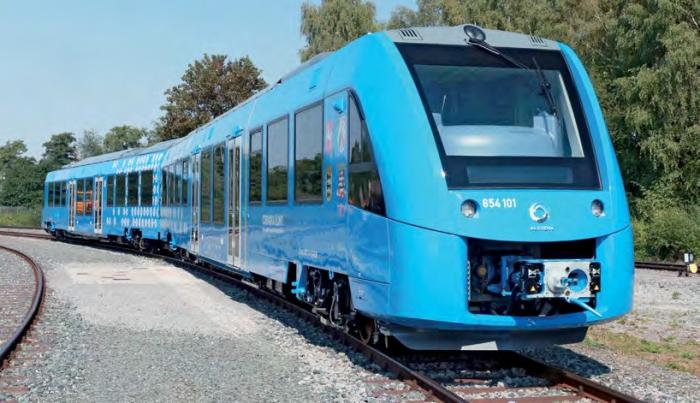
POLITICAL SUPPORT
‘From now on there will be a real alternative to diesel trains in non-electrified rail transport. Hydrogen and fuel cells are an ideal combination for climate protection as well as for the energy and transport revolution. They allow the storage of energy and emission-free travelling on rail. We fund innovative technologies and make a sustainable contribution to the energy revolution in the transport sector. I am pleased that Alstom will build the trains in Lower Saxony, thus further strengthening their production site in Salzgitter.’ Olaf Lies, Economy and Transport Minister of Lower Saxony
